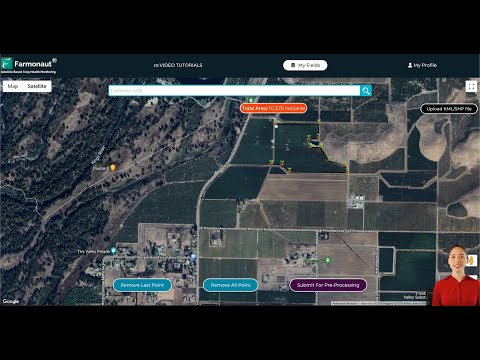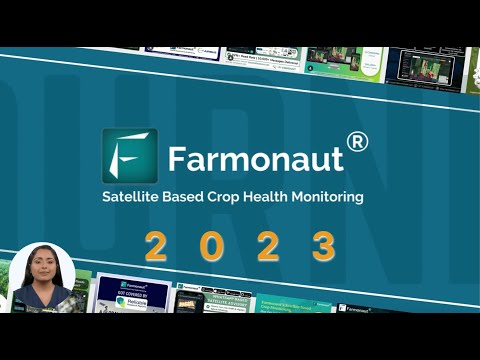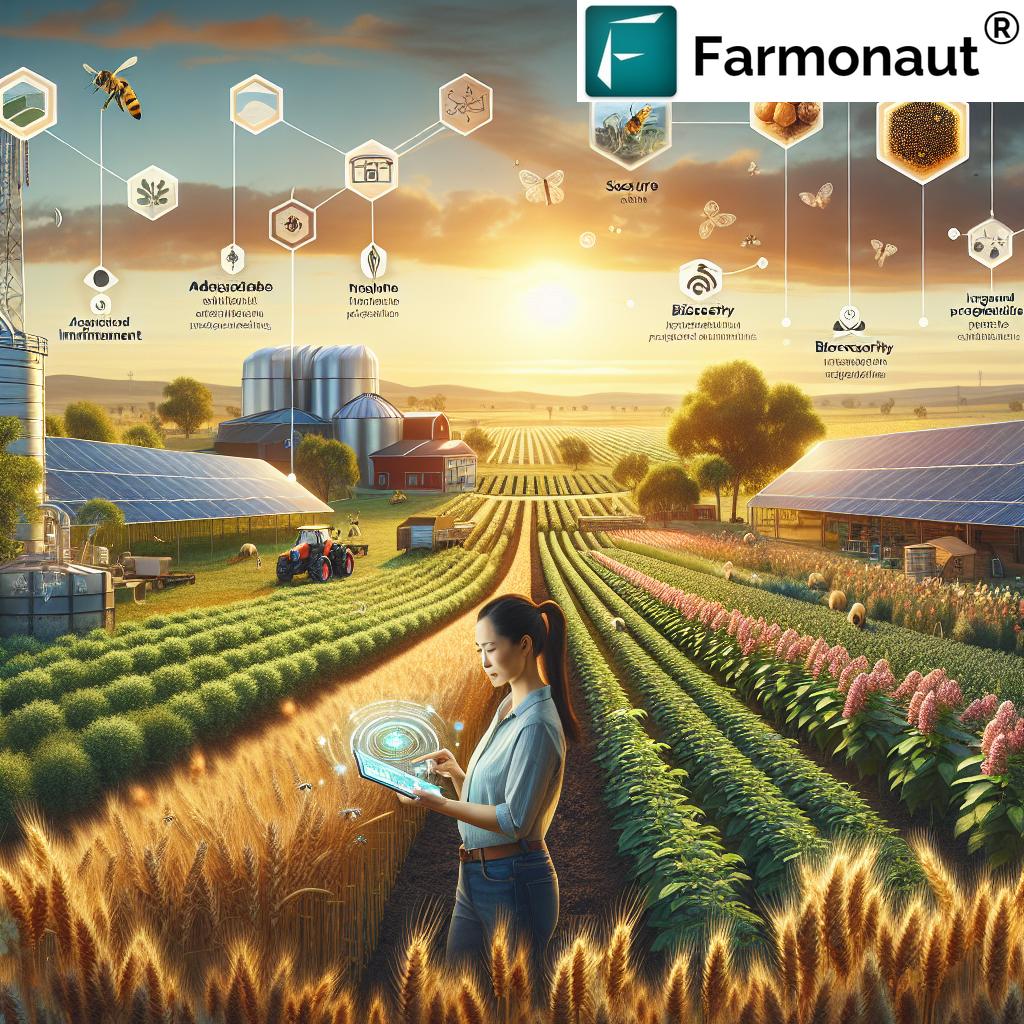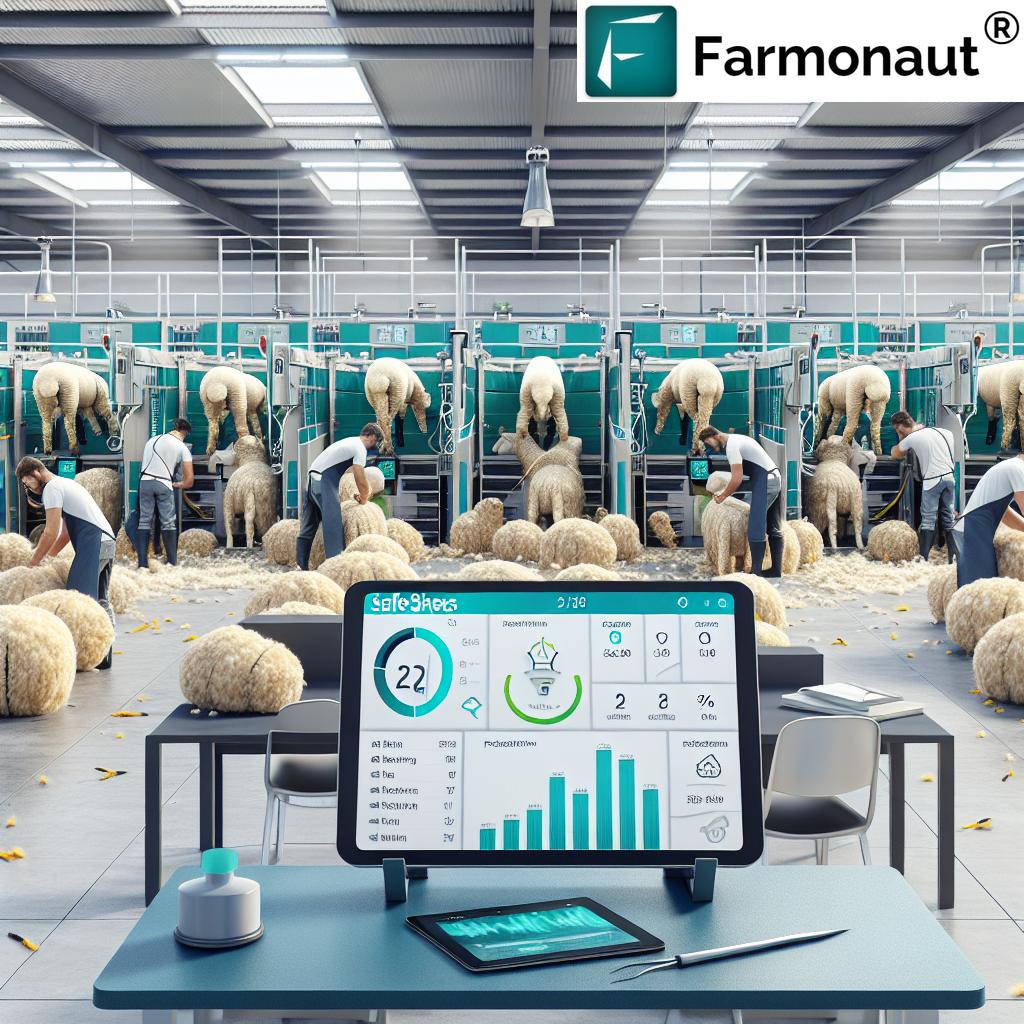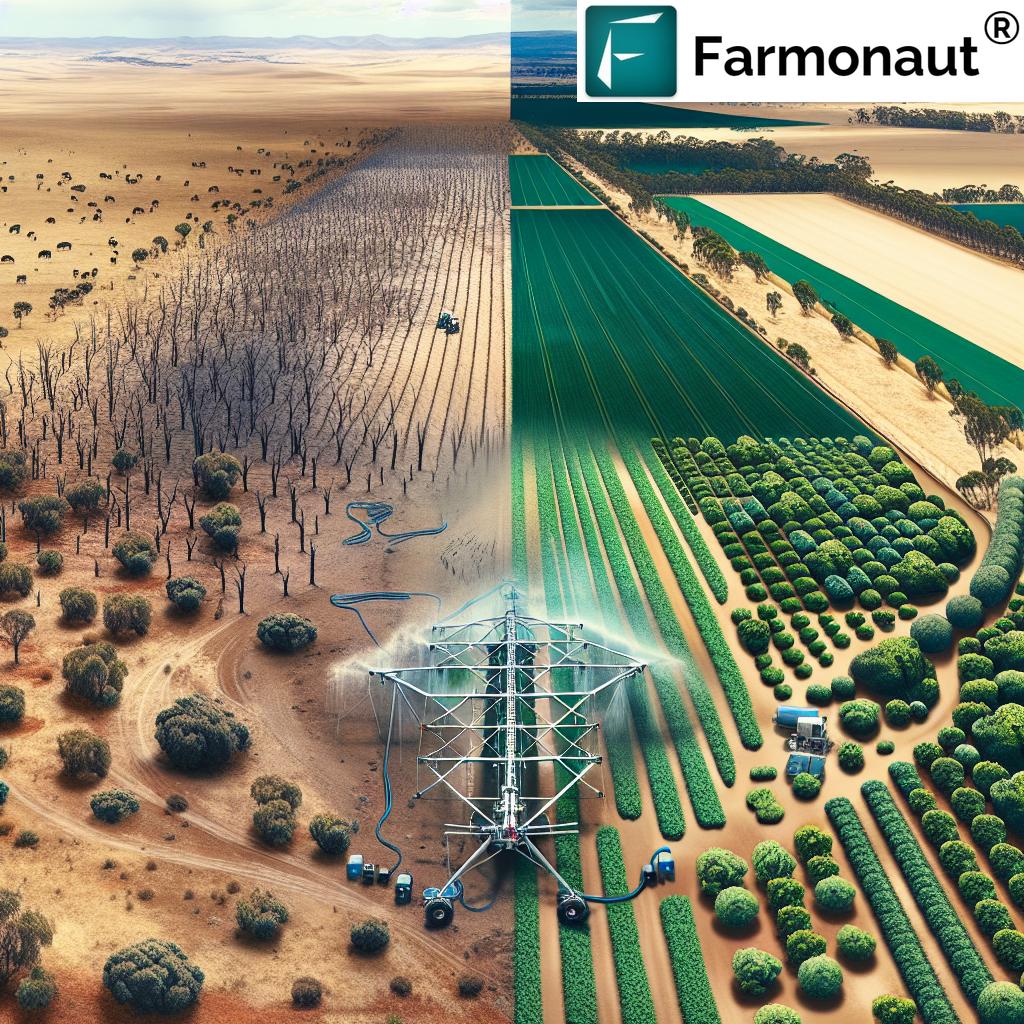Sustainable Ranching Revolution: Boosting Efficiency and Profitability with Eco-Friendly Techniques in Australia
“Rotational grazing can increase livestock productivity by up to 30% while improving soil health.”
In the vast landscapes of Australia, a revolution is taking place in the ranching industry. We’re witnessing a transformation that’s not just changing the way we raise livestock, but also how we interact with our environment and secure our agricultural future. This sustainable ranching revolution is reshaping the industry, boosting efficiency and profitability while embracing eco-friendly techniques that promise a brighter, greener future for Australian agriculture.
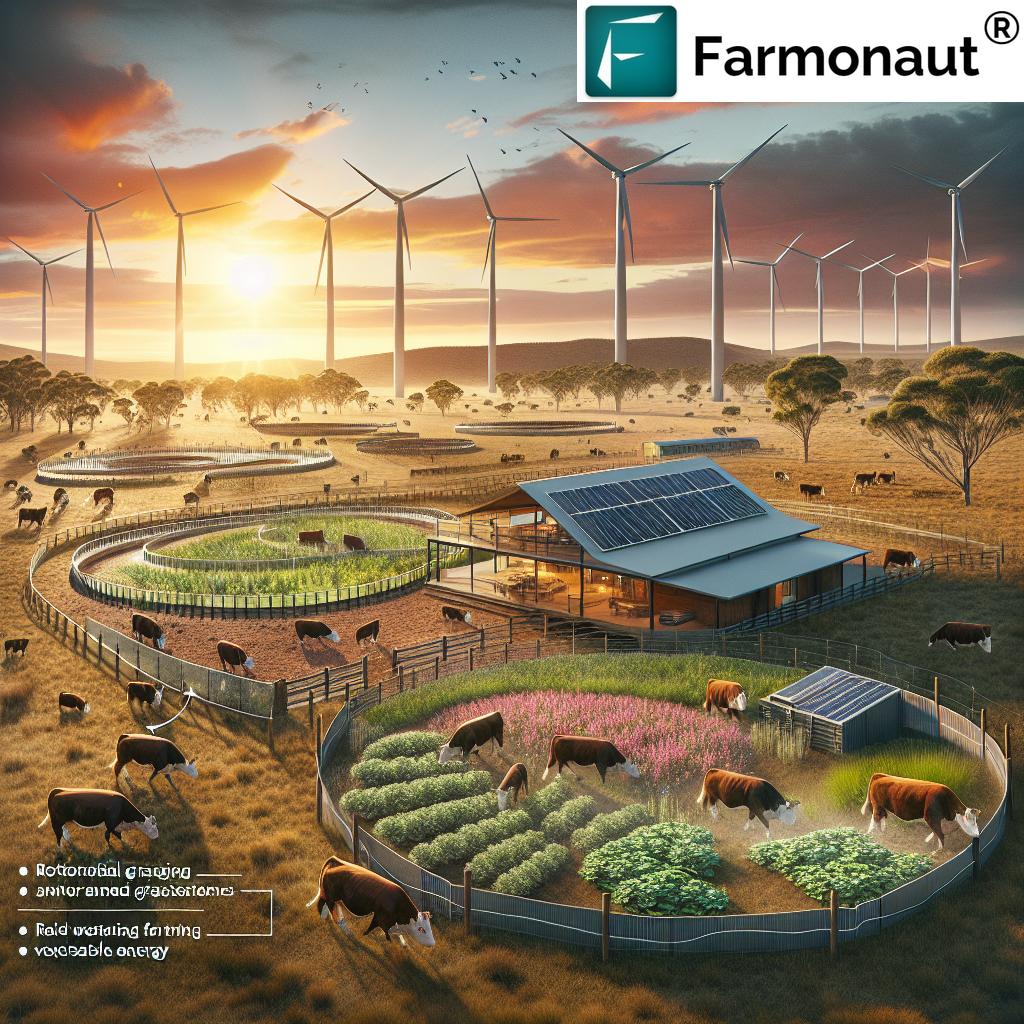
As we delve into this transformative journey, we’ll explore how ranchers across Australia are adopting innovative practices that not only enhance their bottom line but also contribute to the preservation of our unique ecosystem. From the sun-baked plains of Queensland to the rolling hills of Victoria, sustainable ranching practices are taking root, offering a blueprint for a more resilient and profitable agricultural sector.
The Pillars of Sustainable Ranching
Sustainable ranching is built on several key pillars that work in harmony to create a more efficient, profitable, and environmentally friendly approach to livestock management. Let’s explore these fundamental aspects:
- Rotational Grazing: A cornerstone of sustainable ranching
- Soil Conservation: Preserving the foundation of agricultural prosperity
- Water Management: Optimizing a precious resource
- Biodiversity Enhancement: Fostering a balanced ecosystem
- Technological Integration: Leveraging innovation for efficiency
Rotational Grazing: A Game-Changer for Australian Ranches
Rotational grazing stands out as one of the most impactful sustainable ranching practices. This method involves systematically moving livestock through different pastures or paddocks, allowing each area time to recover and regrow before being grazed again. The benefits of this approach are multifaceted:
- Improved pasture quality and productivity
- Enhanced soil health through natural fertilization
- Reduced erosion and soil compaction
- Increased carbon sequestration in the soil
- Better distribution of nutrients across the land
By implementing rotational grazing, Australian ranchers are seeing remarkable improvements in both the health of their land and the productivity of their herds. This sustainable technique not only boosts profitability but also contributes to the long-term viability of ranching operations.
Soil Conservation: The Foundation of Sustainable Ranching
Healthy soil is the bedrock of successful ranching, and sustainable practices place a strong emphasis on soil conservation. In Australia, where soil degradation has been a significant concern, ranchers are adopting techniques that protect and enhance soil quality:
- Minimizing tillage to preserve soil structure
- Planting cover crops to prevent erosion and add organic matter
- Implementing contour plowing on sloped terrain
- Using organic fertilizers and compost to improve soil fertility
These soil conservation strategies not only improve the land’s productivity but also increase its resilience to drought and extreme weather events, which are becoming more frequent in Australia due to climate change.
Water Management: Optimizing a Precious Resource
In a country known for its arid regions and periodic droughts, efficient water management is crucial for sustainable ranching. Australian ranchers are implementing innovative water conservation techniques:
- Installing efficient irrigation systems
- Harvesting rainwater for livestock and pasture use
- Creating water retention landscapes to maximize natural water storage
- Using drought-resistant grass species in pastures
By optimizing water usage, ranchers can maintain productivity even in challenging climatic conditions, ensuring the long-term sustainability of their operations.
Technological Integration in Sustainable Ranching
The integration of technology plays a crucial role in the sustainable ranching revolution. Australian ranchers are increasingly turning to innovative solutions to enhance their operational efficiency and environmental stewardship. One such solution that’s making waves in the industry is Farmonaut, a pioneering agricultural technology company offering advanced, satellite-based farm management solutions.
Farmonaut’s platform provides valuable services such as real-time crop health monitoring, AI-based advisory systems, and resource management tools. These technologies are particularly beneficial for ranchers looking to optimize their grazing strategies and improve overall land management.
Here’s how technology is revolutionizing sustainable ranching practices:
- Satellite Imagery and Remote Sensing: Enables ranchers to monitor pasture health and make informed decisions about grazing rotations.
- AI-Powered Analytics: Provides insights on optimal stocking rates and predicts potential issues before they become problematic.
- GPS Tracking of Livestock: Allows for more efficient herd management and helps prevent overgrazing in specific areas.
- Automated Water Systems: Ensure consistent water supply across the ranch while minimizing waste.
- Soil Moisture Sensors: Help in making data-driven decisions about irrigation and pasture management.
By leveraging these technological advancements, Australian ranchers can significantly improve their operational efficiency while adhering to sustainable practices.
Economic Benefits of Sustainable Ranching
While the environmental advantages of sustainable ranching are clear, it’s crucial to understand that these practices also offer significant economic benefits. Australian ranchers who have embraced sustainable techniques are experiencing:
- Reduced input costs through more efficient resource use
- Improved livestock health, leading to higher quality products
- Increased resilience to market fluctuations and climate variability
- Access to premium markets that value sustainably produced meat and wool
- Long-term land value appreciation due to improved soil health and biodiversity
These economic benefits underscore the fact that sustainable ranching is not just an environmental imperative but also a smart business decision for Australian ranchers.
“Sustainable ranching practices can reduce water usage on farms by 20-40% compared to traditional methods.”
Biodiversity Enhancement: Fostering a Balanced Ecosystem
Sustainable ranching practices in Australia are not just about livestock management; they’re about creating a harmonious balance with the natural ecosystem. By enhancing biodiversity, ranchers are seeing multiple benefits:
- Increased natural pest control, reducing the need for chemical pesticides
- Improved pollination services, benefiting both pastures and nearby crops
- Enhanced resilience to environmental stresses
- Creation of wildlife corridors, supporting native species
Ranchers are implementing various strategies to promote biodiversity:
- Maintaining and restoring native vegetation
- Creating buffer zones around water bodies
- Implementing agroforestry systems
- Protecting and enhancing wildlife habitats
These efforts not only contribute to the overall health of the ecosystem but also create opportunities for additional income streams through ecotourism and carbon credits.
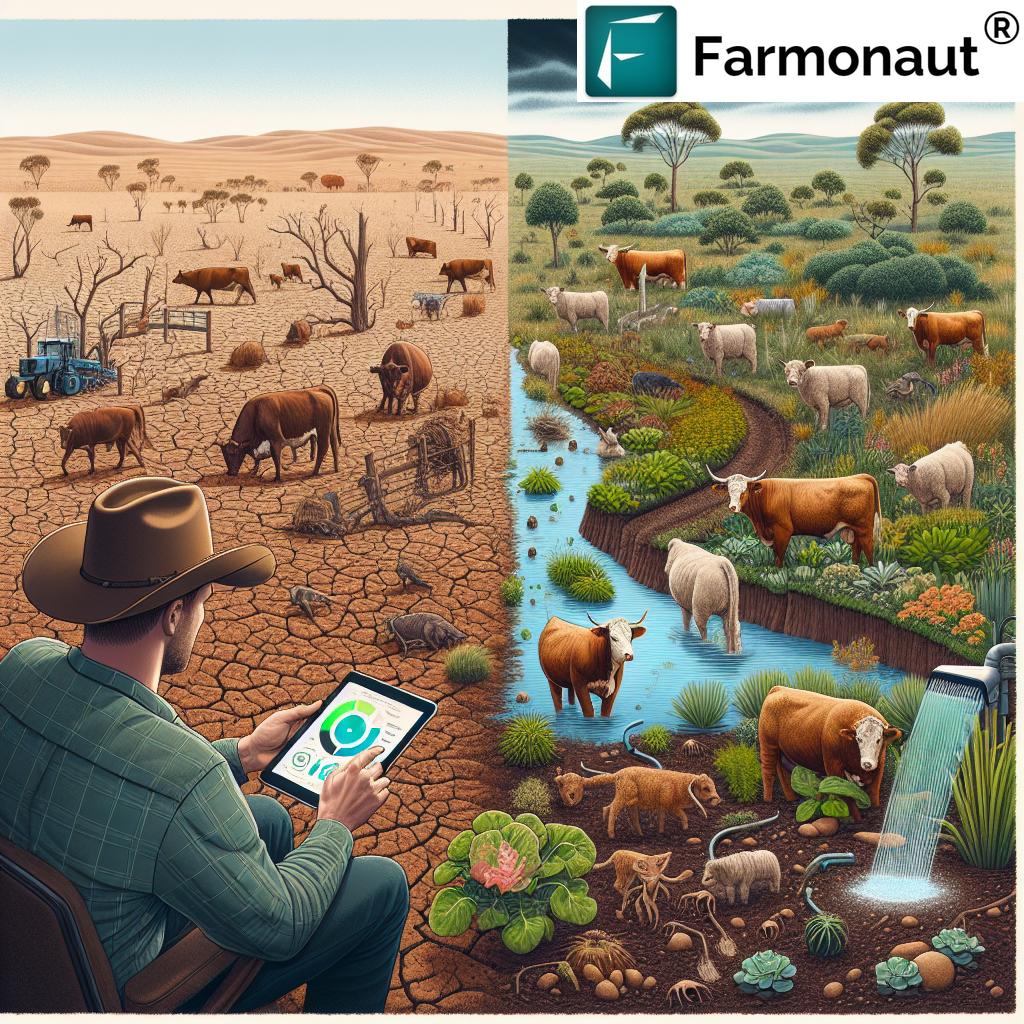
The Role of Technology in Sustainable Ranching
As we delve deeper into the technological aspects of sustainable ranching, it’s important to highlight how cutting-edge solutions are making a significant impact. Farmonaut’s agricultural technology is at the forefront of this revolution, offering tools that are particularly valuable for ranchers:
- Satellite-Based Crop Health Monitoring: While primarily designed for crop farmers, this technology is equally beneficial for ranchers managing pastures. It provides insights into vegetation health (NDVI) and soil moisture levels, crucial for optimizing grazing patterns.
- AI Advisory System: Farmonaut’s Jeevn AI delivers real-time insights and expert management strategies, helping ranchers make informed decisions about herd movement, pasture rest periods, and resource allocation.
- Fleet and Resource Management: For larger ranching operations, efficient management of vehicles and machinery is crucial. Farmonaut’s tools help optimize vehicle usage and improve overall operational efficiency.
- Carbon Footprinting: As sustainability becomes increasingly important, ranchers can use this feature to monitor and reduce their environmental impact, potentially opening up new market opportunities for carbon-conscious consumers.
These technological solutions are not just enhancing efficiency; they’re transforming the way ranchers approach their day-to-day operations, making sustainable practices more accessible and manageable.
Explore Farmonaut’s API for advanced agricultural data integration
Access Farmonaut’s API Developer Docs for technical integration details
Challenges and Solutions in Implementing Sustainable Ranching
While the benefits of sustainable ranching are clear, implementation can come with its own set of challenges. Australian ranchers face several hurdles in transitioning to more sustainable practices:
- Initial Costs: Implementing new technologies and practices often requires upfront investment.
- Knowledge Gap: Transitioning to sustainable methods requires learning new skills and techniques.
- Resistance to Change: Traditional ranching methods are deeply ingrained, and change can be met with skepticism.
- Climate Variability: Australia’s harsh and unpredictable climate can make implementing new practices challenging.
However, these challenges are not insurmountable. Here are some solutions that are helping Australian ranchers overcome these obstacles:
- Government Incentives: Programs that provide financial support for implementing sustainable practices.
- Education and Training: Workshops and courses offered by agricultural organizations to bridge the knowledge gap.
- Peer Networks: Platforms for ranchers to share experiences and best practices in sustainable ranching.
- Phased Implementation: Gradually introducing sustainable practices to manage costs and minimize disruption.
- Technology Adoption: Utilizing platforms like Farmonaut to ease the transition and improve decision-making.
By addressing these challenges head-on, Australian ranchers are paving the way for a more sustainable and profitable future in the industry.
The Future of Sustainable Ranching in Australia
As we look towards the future, the trajectory of sustainable ranching in Australia is incredibly promising. The combination of innovative practices, technological advancements, and a growing commitment to environmental stewardship is setting the stage for a transformation in the industry. Here’s what we can expect in the coming years:
- Increased Adoption of Precision Ranching: More ranchers will leverage data-driven decision-making tools, like those offered by Farmonaut, to optimize their operations.
- Carbon Neutral Ranching: With growing emphasis on carbon footprinting, we’ll likely see more ranches striving for carbon neutrality through improved grazing practices and carbon sequestration.
- Diversification of Income Streams: Sustainable ranches will increasingly explore additional revenue sources such as agritourism and ecosystem services.
- Enhanced Collaboration: Greater cooperation between ranchers, researchers, and technology providers will drive innovation in sustainable practices.
- Consumer-Driven Change: As consumers become more environmentally conscious, demand for sustainably produced meat and wool will continue to grow, further incentivizing sustainable practices.
The future of ranching in Australia is not just about maintaining the status quo; it’s about reimagining the industry as a key player in environmental conservation and sustainable food production. By embracing these changes, Australian ranchers are not only securing their own future but also contributing to global efforts in sustainable agriculture.
Comparative Analysis: Traditional vs. Sustainable Ranching
To fully appreciate the impact of sustainable ranching practices, it’s helpful to compare them directly with traditional methods. The following table provides a clear overview of how sustainable techniques stack up against conventional approaches in various aspects of ranching:
| Ranching Aspect | Traditional Method | Sustainable Technique | Environmental Impact | Profitability Impact |
|---|---|---|---|---|
| Grazing Management | Continuous grazing on large pastures | Rotational grazing with planned rest periods | Improved soil health, increased biodiversity | Higher pasture productivity, better livestock health |
| Soil Conservation | Minimal intervention, potential overgrazing | Active soil management, cover cropping | Reduced erosion, increased carbon sequestration | Long-term land value appreciation, higher yields |
| Water Resource Management | Conventional irrigation, potential overuse | Efficient irrigation systems, water harvesting | Reduced water waste, improved water quality | Lower water costs, resilience to drought |
| Livestock Health | Reactive health management, heavy use of antibiotics | Preventive care, natural remedies, stress reduction | Reduced chemical runoff, antibiotic resistance prevention | Lower veterinary costs, premium prices for antibiotic-free meat |
| Technology Integration | Limited use of technology | Advanced monitoring systems, AI-driven decision making | Optimized resource use, reduced environmental footprint | Increased operational efficiency, data-driven profitability |
This comparison clearly illustrates the multifaceted benefits of sustainable ranching practices. While traditional methods have served the industry for generations, the shift towards sustainable techniques offers significant advantages in terms of environmental stewardship and long-term profitability.
Case Studies: Success Stories from Australian Ranches
To further illustrate the real-world impact of sustainable ranching practices, let’s look at some success stories from across Australia. These examples demonstrate how ranchers are successfully implementing eco-friendly techniques to boost both efficiency and profitability:
- Central Queensland Cattle Station: Implemented rotational grazing and saw a 25% increase in carrying capacity within two years, along with improved soil health.
- Western Australian Sheep Farm: Adopted precision agriculture techniques using Farmonaut’s satellite imagery, resulting in 30% water savings and more efficient pasture management.
- Victorian Mixed Livestock Operation: Integrated agroforestry practices, creating additional income streams through carbon credits while improving overall biodiversity.
- Northern Territory Cattle Ranch: Utilized AI-driven herd management tools, leading to a 15% reduction in input costs and improved animal welfare outcomes.
These success stories highlight the tangible benefits of embracing sustainable ranching practices and leveraging technology to enhance operational efficiency.
The Role of Government and Industry Bodies
The transition to sustainable ranching practices in Australia is being supported and accelerated by various government initiatives and industry organizations. These entities play a crucial role in providing resources, funding, and guidance to ranchers looking to adopt more sustainable methods:
- Government Grants and Incentives: Programs that offer financial support for implementing water-saving technologies or soil conservation practices.
- Research and Development Funding: Allocation of resources to develop new sustainable ranching technologies and practices tailored to Australian conditions.
- Industry Associations: Organizations that provide training, resources, and networking opportunities for ranchers interested in sustainable practices.
- Certification Programs: Development of sustainability certifications that can help ranchers access premium markets for their products.
These initiatives are crucial in creating an enabling environment for the widespread adoption of sustainable ranching practices across Australia.
Consumer Trends and Market Opportunities
The shift towards sustainable ranching is not just driven by environmental concerns and operational efficiencies; it’s also responding to changing consumer preferences and new market opportunities:
- Growing Demand for Sustainable Products: Consumers are increasingly seeking out meat and wool products that are produced using environmentally friendly methods.
- Premium Pricing: Sustainably produced livestock products often command higher prices in the market, offering better returns for ranchers.
- Export Opportunities: Many international markets are placing a higher value on sustainably produced agricultural products, opening new export avenues for Australian ranchers.
- Brand Storytelling: Sustainable practices provide ranchers with compelling stories to connect with consumers and differentiate their products in the marketplace.
By aligning with these consumer trends, Australian ranchers can not only contribute to environmental conservation but also tap into lucrative market segments.
The Global Context: Australia’s Role in Sustainable Agriculture
Australia’s efforts in sustainable ranching are not occurring in isolation. They are part of a global movement towards more sustainable agricultural practices. As one of the world’s major agricultural producers, Australia’s adoption of sustainable ranching techniques has far-reaching implications:
- Setting Global Standards: Australian innovations in sustainable ranching can serve as models for other countries facing similar environmental challenges.
- Contributing to Climate Change Mitigation: By improving carbon sequestration and reducing emissions, Australian ranches are playing a part in global climate action.
- Enhancing Food Security: Sustainable practices ensure long-term productivity, contributing to global food security efforts.
- Driving Technological Innovation: Australia’s unique challenges are spurring the development of new agricultural technologies that can be applied globally.
By embracing sustainable ranching, Australia is not just securing its own agricultural future but also contributing to global efforts in sustainable food production and environmental conservation.
Conclusion: Embracing the Sustainable Ranching Revolution
As we’ve explored throughout this blog post, the sustainable ranching revolution in Australia represents a significant shift in how we approach livestock management and land stewardship. By embracing eco-friendly techniques and leveraging cutting-edge technologies like those offered by Farmonaut, Australian ranchers are not only boosting their efficiency and profitability but also playing a crucial role in environmental conservation.
The benefits of sustainable ranching extend far beyond the immediate improvements in soil health and water management. They encompass enhanced biodiversity, increased resilience to climate change, and the opening of new market opportunities. As consumers become increasingly conscious of the environmental impact of their food choices, sustainably produced meat and wool products are likely to see growing demand both domestically and internationally.
The transition to sustainable ranching is not without its challenges, but with the support of government initiatives, industry bodies, and innovative technology companies, Australian ranchers are well-positioned to overcome these hurdles. The success stories we’ve seen across the country demonstrate that sustainable practices are not just environmentally responsible but also economically viable.
As we look to the future, it’s clear that sustainable ranching will play a pivotal role in shaping Australia’s agricultural landscape. By continuing to innovate, collaborate, and adopt eco-friendly practices, Australian ranchers can ensure the long-term viability of their operations while contributing to global efforts in sustainable agriculture and climate change mitigation.
The sustainable ranching revolution is more than just a trend; it’s a necessary evolution of the industry. As we face the challenges of a changing climate and growing global food demand, the practices and principles of sustainable ranching offer a path forward that balances productivity with environmental stewardship. For Australian ranchers, embracing this revolution is not just an opportunity – it’s an imperative for a prosperous and sustainable future.
FAQ Section
Q: What is sustainable ranching?
A: Sustainable ranching refers to livestock management practices that maintain or enhance environmental quality while improving the economic viability of the ranch. It includes techniques like rotational grazing, soil conservation, efficient water management, and the use of technology to optimize operations.
Q: How does sustainable ranching benefit the environment?
A: Sustainable ranching benefits the environment by improving soil health, enhancing biodiversity, reducing water usage, minimizing erosion, and potentially sequestering carbon in the soil. These practices help maintain ecosystem balance and mitigate the environmental impact of livestock production.
Q: Can sustainable ranching practices really improve profitability?
A: Yes, sustainable ranching can improve profitability through various means:
- Reduced input costs (e.g., lower water and feed expenses)
- Improved livestock health leading to better product quality
- Access to premium markets for sustainably produced products
- Long-term land value appreciation due to improved soil health
- Potential additional income streams like carbon credits or ecotourism
Q: What role does technology play in sustainable ranching?
A: Technology plays a crucial role in sustainable ranching by providing tools for:
- Precision agriculture and resource management
- Real-time monitoring of livestock and pasture health
- Data-driven decision making for grazing and herd management
- Efficient water and energy use
- Tracking and reducing environmental impact
Companies like Farmonaut offer advanced solutions that integrate satellite imagery, AI, and data analytics to support sustainable ranching practices.
Q: How can Australian ranchers start transitioning to more sustainable practices?
A: Australian ranchers can start transitioning to sustainable practices by:
- Educating themselves through workshops and training programs
- Gradually implementing practices like rotational grazing
- Investing in water-saving technologies
- Adopting soil conservation techniques
- Utilizing technologies like Farmonaut for data-driven management
- Seeking advice from agricultural extension services or sustainable farming consultants
- Exploring government incentives and support programs for sustainable agriculture
Q: Are there any certification programs for sustainable ranching in Australia?
A: Yes, there are several certification programs that recognize sustainable ranching practices in Australia. These include organic certifications, sustainability assurance programs run by industry bodies, and emerging carbon neutral certifications. However, it’s important to note that certification requirements can vary, and ranchers should research the options that best fit their specific practices and market goals.



